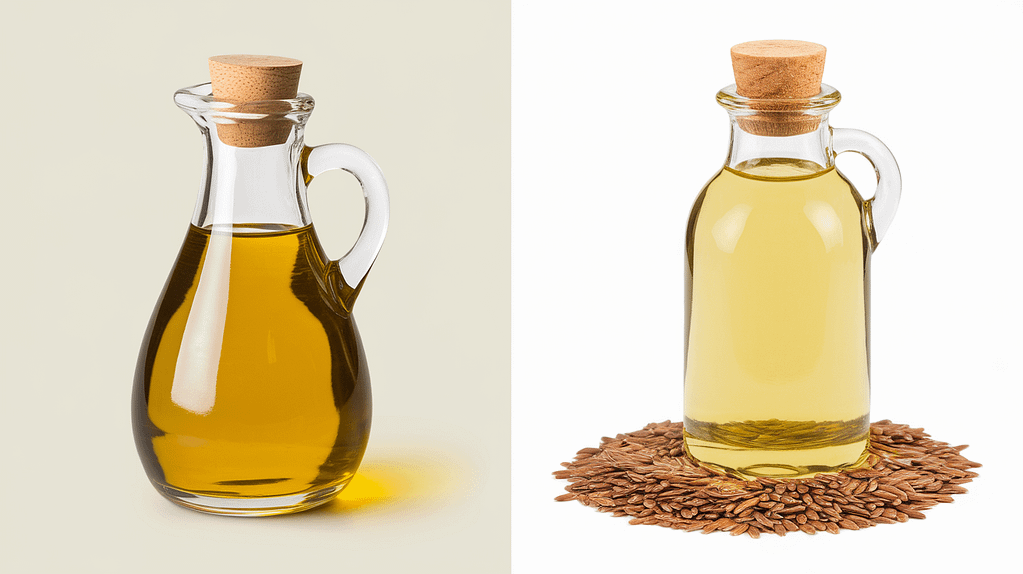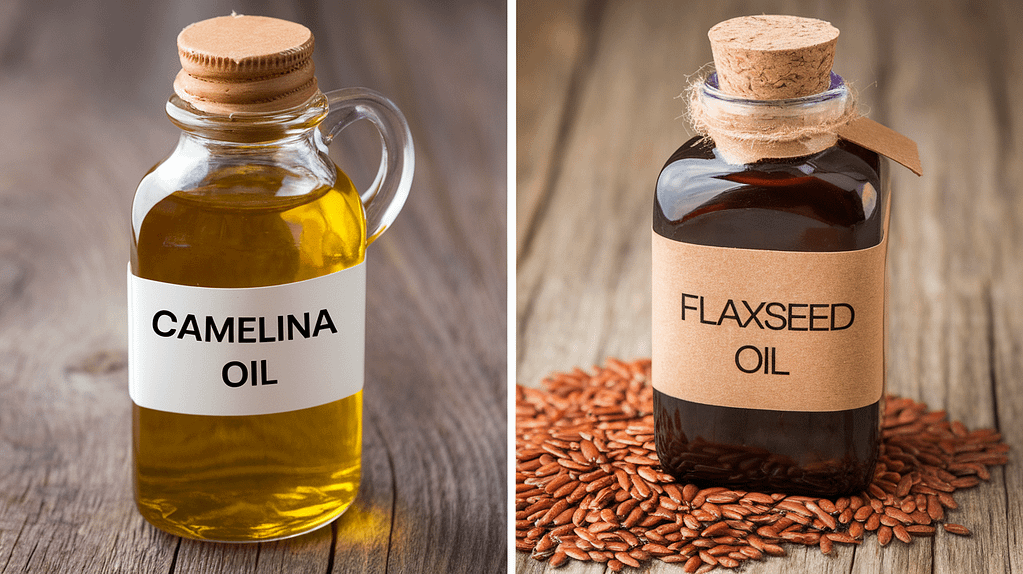GroceryBrands.net is a participant in the Amazon Services LLC Associates Program. When you click our Amazon affiliate links and make a purchase, we earn a commission at no extra cost to you.
The main difference in camelina oil and flaxseed oil lies in their composition, stability, and culinary applications. Both are rich in essential fatty acids, particularly omega-3, making them valuable additions to a balanced diet. Despite their similarities, they have distinct properties that influence their usability in cooking, skincare, and overall wellness. Understanding these differences can help in choosing the right oil based on individual health goals and culinary preferences.
Nutritional Comparison
Both camelina oil and flaxseed oil provide beneficial nutrients, but they differ in their composition, which affects their stability, shelf life, and overall impact on health.

Omega-3 Fatty Acid Content
Flaxseed oil is widely recognized for its exceptionally high concentration of alpha-linolenic acid (ALA), an essential omega-3 fatty acid. This oil contains approximately 50-60% ALA, making it one of the most potent plant-based sources of omega-3s. Regular consumption of flaxseed oil can help support cardiovascular health, brain function, and inflammation reduction.
Camelina oil, on the other hand, contains a slightly lower omega-3 content, ranging between 35-40%. However, what makes camelina oil unique is its balanced ratio of omega-3, omega-6, and omega-9 fatty acids. This composition ensures that the body receives a more even distribution of healthy fats, which supports overall well-being and long-term nutritional stability.
Vitamin E and Antioxidants
Camelina oil has a significant advantage in terms of antioxidant content, particularly vitamin E. This nutrient acts as a natural preservative, preventing oxidation and prolonging the oil’s shelf life. Vitamin E is also beneficial for skin health, offering protection against free radicals that contribute to aging and cellular damage. The high antioxidant content makes camelina oil a more stable choice for cooking and skincare applications.
Flaxseed oil, while still offering some vitamin E, has a considerably lower amount compared to camelina oil. This makes it more prone to oxidation and rancidity, requiring careful storage and handling to maintain its quality and effectiveness.
Protein and Fiber Content
Since both oils are extracted from seeds, they do not contain any protein or fiber. However, whole flaxseeds are commonly consumed as a fiber-rich food, providing digestive benefits and promoting gut health. While camelina seeds are primarily used for oil extraction, they do not offer the same fiber benefits as whole flaxseeds.
Health Benefits
Both oils contribute to improved health, but their unique compositions provide distinct advantages in different areas.
Heart Health
Omega-3 fatty acids play a crucial role in maintaining cardiovascular health by reducing inflammation, lowering cholesterol levels, and improving overall heart function. Flaxseed oil, due to its high ALA content, is particularly beneficial for lowering LDL cholesterol and reducing the risk of heart disease. It is often recommended for individuals looking to improve their lipid profile and maintain a healthy cardiovascular system.
Camelina oil, while slightly lower in omega-3 content, provides a more stable source of these essential fatty acids. Its balanced fatty acid ratio ensures long-term usability and prevents the rapid oxidation that can sometimes occur with flaxseed oil. This makes it a reliable choice for individuals looking for consistent heart health support over time.
Skin and Hair Benefits
Camelina oil is a preferred choice for skincare and haircare applications due to its high vitamin E content and well-balanced fatty acid composition. When applied topically, it helps moisturize and protect the skin, reducing dryness and irritation. It also strengthens hair, promoting shine and reducing breakage. Due to its stability, camelina oil can be incorporated into lotions, serums, and hair treatments without the risk of quick degradation.
Flaxseed oil also provides skin benefits but is more commonly consumed internally for its anti-inflammatory effects rather than used as a topical application. Regular intake of flaxseed oil may help improve skin elasticity and hydration from within, but its susceptibility to oxidation limits its external use compared to camelina oil.
Anti-Inflammatory Properties
Both oils help combat inflammation, making them beneficial for individuals suffering from chronic inflammatory conditions such as arthritis, autoimmune disorders, and digestive issues. Flaxseed oil’s high omega-3 concentration makes it a powerful anti-inflammatory agent, aiding in pain relief and reducing symptoms associated with inflammatory diseases.
Camelina oil, while slightly lower in omega-3, offers long-term stability and a balanced composition that supports overall inflammatory control. Its resistance to oxidation ensures that it remains effective for a longer duration, providing steady benefits without the risk of degradation.
Culinary Uses
Each oil has specific properties that make it more suitable for different types of cooking and food preparation.

Cooking Applications
Camelina oil has a remarkably high smoke point of approximately 475°F (240°C), making it an excellent choice for high-heat cooking methods such as sautéing, roasting, and even frying. The oil retains its nutritional integrity at high temperatures, ensuring that the essential fatty acids remain beneficial even after cooking.
Flaxseed oil, in contrast, has a low smoke point of about 225°F (107°C). This makes it unsuitable for high-temperature cooking, as excessive heat can degrade its delicate omega-3 content. Instead, flaxseed oil is best used in cold applications such as salad dressings, smoothies, and drizzling over prepared dishes to preserve its nutritional value.
Taste and Flavor Profile
Flaxseed oil has a distinct nutty and slightly bitter taste, which some people may find overpowering in certain recipes. It is commonly mixed with other ingredients to balance its strong flavor.
Camelina oil, on the other hand, has a milder, nutty, and slightly earthy taste, making it more versatile in various dishes. Its pleasant flavor allows it to be used in salad dressings, marinades, and even drizzled over cooked vegetables for an enhanced taste.
Storage and Shelf Life
Proper storage is essential to maintain the quality and effectiveness of both oils.
Shelf Stability
Camelina oil is significantly more stable than flaxseed oil due to its high vitamin E content, which acts as a natural preservative. This allows camelina oil to remain fresh for up to 12 months when stored properly. Its stability makes it a practical choice for everyday cooking and long-term storage.
Flaxseed oil, however, is more fragile and tends to go rancid within 3-6 months, even when stored under optimal conditions. Its susceptibility to oxidation necessitates careful handling to prevent spoilage.
Proper Storage Methods
Flaxseed oil should always be kept in a cool, dark place and refrigerated after opening to slow down oxidation. Exposure to heat and light can quickly degrade its quality, reducing its effectiveness.
Camelina oil, being more resistant to oxidation, can be stored at room temperature without immediate concerns. However, keeping it in a dark, cool location helps maintain its freshness and prolongs its usability.
Choosing the Right Oil
Selecting between camelina oil and flaxseed oil depends on dietary goals, cooking habits, and storage preferences. Flaxseed oil is a top choice for those prioritizing a high omega-3 intake through cold applications. Meanwhile, camelina oil provides a balanced nutritional profile, a higher smoke point, and greater shelf stability, making it more versatile for various culinary and health needs. Including both oils in a well-rounded diet ensures the benefits of their unique properties.
